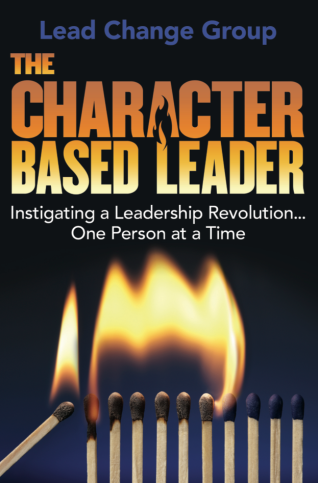A few years ago, after discussing ideas and principles of leadership with a great cross-section of contributors, I packed my bags and headed to sunny Florida for the first Lead Change gathering.
Since that initial gathering, Mike Henry, a catalyst for change in leadership along with dozen of others have collaborated to deliver The Character Based Leader. Since receiving a copy, I have highlighted it’s pages, made some notes and would like to shares a few ideas.
So, What is Character-Based Leadership?
From Lead Change discussions a definition surfaced, “Character-based leadership is leading from who you are rather than from power or position.”
Lead Change as a group recognized that “we have a crisis of leadership and a need to personally be involved in changing the world of leadership for the better. It’s not that we feel leadership development is the problem, rather that the current methods aren’t keeping pace with the need expressed by individuals. In a way, individuals in the world are in search of leadership help faster and in a greater variety than is being provided.”

The Simple Truth of Leadership
John Maxwell famously stated, “Leadership is influence, plain and simple.”
It’s not meant to be a power trip or laden with methods and a roadmap on how to get there.
We constantly read and hear about leaders how misuse their power while in leadership or positions of influence. “The crisis is in people’s character, not in the positions that people attain” shared Don Shapiro.
Shapiro continues, “To produce a world of great leaders at home, in the community and in organizations, the time has come to make people’s character priority number one.”
Underlying Principles
The three core principles highlighted throughout the Character Based Leader include:
- Leadership is influence
- influence is given
- People give influence based on competence, trust and purpose.
These principles are the essence of great leadership and happen as we inspire.
Simon Sinek stated, “We can only inspire or manipulate.” Each of us possesses the freedom to make choices and it’s up to us to decide whether we inspire or manipulate. Where will you lead? Where do you stand?
Lead from Where You Are
While we have to lead from where we are, we have to understand who we are. Lisa Petrilli shared, “There is no escaping the fact that when we show up for work and for our leadership roles, we bring the entirety of ourselves to the table. We bring our convictions, our strengths, our ideas, and our weaknesses, along with our insecurities, knowledge of our past failures, pride in our past accomplishments, and our desire to lead our teams successfully.”
When’s the last time we sat in a quiet place and assessed who we are, what we stand for, and looked at our strengths and weaknesses along with life’s lessons and what we should be learning and doing? Do we accept our whole selves and truly understand where we are taking ourselves and not just those we lead? How can we lead others when we may be lost on the leadership trail?
How Can I Make a Change?
Page Cole surfaced that “leading from your strengths is more than just admitting you are good at something. It also involves the next phase of leadership which is discovering what it is that you do really well.” Page continues, “The challenge for leaders is that this is less like a mining expedition and more like working in a laboratory.”
Each of us has a laboratory whether at home, the office, in the committee, and we need to consistently experiment and discover who we are, surface and assess our strengths, admit we have weaknesses and allow those in the labs to contribute to our change while we provide an avenue for the same.
I believe we need to tell more stories about our experiences and allow others to ask questions. Not too long ago, one of my children, a new homeowner called with a few questions. He said, “Have you ever renovated a bathroom that was built on solid concrete? Do you know how much labor it’s going to take and what it’s going to cost to complete the renovation?”
We discussed the project and the options he could take. I let him know that he was on the right track, validated the options and gave him a few suggestions. While this may seem like a conversation, he was telling me a story. I was able to share my experiences (some not so good) and we laughed some, but it gave him the outlet to move forward with the renovation. Both of us led from our strengths and experiences and opened the door to change. (As a side note, he learned that a jack hammer was crucial for the job.)
The laboratories I experiment in have surfaced things about me that I may have known or didn’t. I was asked to share what my strengths were to several people I had never met. I thought about it for a second told them who I was, what I believed and how I led. Immediately, there was a connection and the conversation continued as an open and less guarded discussion.
Reading the Character Based Leader has reinforced a few things I know about character-based leadership and taught me a few things I didn’t know. First, we have to persevere and be steadfast. Second, we have to surface concerns in leadership and address those head on. You can’t wimp out no matter what the consequences. Third, “Character-based leadership is the conscious choice to be an ambassador, to place the greater good, the purpose of the organization and the needs of others above your own desires” shares Chery Gegelman.
Each of us can make a change and we can start now.
Thanks to the authors for their insights, passion and desire to lead a change in leadership. I highly recommend you pick up a copy of the book and he how much of a revolution you can instigate.






